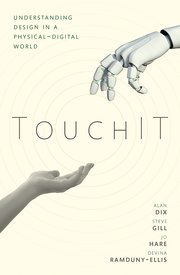For many years interaction design was driven by the abstractions of WIMP (windows, icons, menus, pointer). The details differ on desktop applications, web pages or smart-phones and the ‘pointer’ has evolved from mice to trackpad and touch-based interactions, however, for many digital applications, the central aspects are unchanged. What is different is that the screens we encounter, as Weiser predicted, are everywhere: embedded in physical appliances such as showers and toasters and situated in office walls and building facades. Furthermore, we are often engaging with digital applications that have no obvious screen or where the screen if present is only a small part of the interaction; these include voice assistants, semi-autonomous vehicles, and smart cities.
Even where the dominant interaction is focused on a screen, the places where we use them and the physical activities, we are doing fundamentally affect the nature of the interactive experience: using a smartphone while sitting in an armchair and watching television, is very different from thumbing a quick message whilst walking down a busy city road on a rainy night.
In this talk I will describe several design techniques and prototype tools that seek to address the physicality of digital interactions including the physical nature of the device itself and the physical context in which it is placed. This will include ‘soft’ formal methods to describe physical aspects of devices, ways to use video to model physical prototypes during early design and tools to encourage designers to keep the context of use in mind even when working on largely screen-based interactions.
The talk draws on some long-standing work, parts of the recently published book 'TouchIT: Understanding Design in a Physical-Digital World' (co-authored with Steve Gill, Devina Ramduny-Ellis, and Jo Hare) and the InContext project (in collaboration with Miriam Sturdee and Anna Carter). The latter arose from the realisation that despite the vast number of design tools available, nearly all focus entirely on the screen and wireframes. We are asking "what is the Next Generation of UX design tool?" – perhaps you would like to join this conversation.
|

Alan Labs -- prototypes and more

